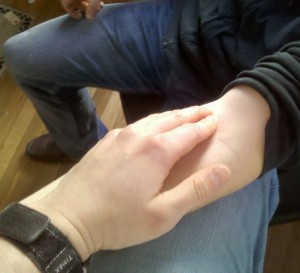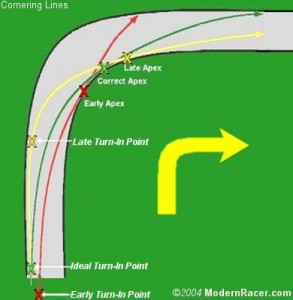For other Vital Signs posts, see: Respirations and Pulse
In the grand scheme of medical skills, taking a manual blood pressure is far from difficult, but sick people and austere conditions can combine to make it another thing entirely. Obtaining a BP on an ill patient while rattling down the road is legitimately one of the most difficult psychomotor skills an EMT-Basic has to master.
Mastering it starts with stacking the odds in your favor. A good stethoscope is better than a lousy one — you don’t need a $500 cardiology model, but something with good insulation and tight-fitting earpieces can make a real difference. Of course, you’ll also want to try to take your blood pressures at times of peace: on scene, before the rig starts moving, or even shoehorned in while stopped at traffic lights.
The elbow-supported technique for finding the brachial pulse is also ideal for taking a BP; trying to hear anything when the arm is slightly flexed is a recipe for frustration. But ensure that however you arrange things, the arm is completely relaxed, because muscular tension can radically throw a measurement; this will require fully supporting the arm and sometimes reassuring the patient. “Just relax” is the line I always deliver while busily pumping the bulb.
Where to put the gauge? Wherever. I’ll usually clip it to one of the stretcher straps, but you can find a bit of blanket that it’ll nestle into, secure it to a shirt, clip it to your watchband or the edge of the cuff, or just ask the patient to hold it for you. The built-in strap on the cuff is only a good location if you’re at the patient’s right side, which is typically not where we sit while we’re transporting. There’s probably a huge market niche out there for “EMS style” cuffs with their handedness reversed… but I digress.
Although I don’t always follow all of these steps, here’s the basic approach I recommend for a routine blood pressure check:
- Support the arm, ideally at a position that is horizontally level with the heart.
- Palpate the antecubital fossa until you find the pulse point. Note this location.
- Palpating at the radial or the AC, pump up the cuff until you lose the pulse. Note this number and deflate the cuff.
- Place your scope on the AC and inflate the cuff past the previous number. Obtain your pressure in the ordinary fashion.
Starting with a palpated pressure may seem redundant, and it can be, but it has two advantages: first, it gives you a rough sense of what systolic to look for, and second, if you’re unable to auscultate a pressure, you’ll still have a palpated one to record. This is actually the officially recommended method, although it seems rarely done nowadays.
Palpated pressures are legitimate, although when they start becoming the norm it can be a sign of lazy care. The diastolic can be a valuable number, though, particularly in traumatic or cardiac cases, so remember that auscultating is still the default standard of care. And remember, particularly if you’re mixing methods, that palpated pressures often will differ from auscultated pressures (including those taken by machine), usually by 10-15 points on the low side.
What if you’re not getting anything from the arm? Well, you can try the other arm, of course. But really, the thing to remember is that you can take a blood pressure anywhere there’s a pulse, although it’s much easier when that pulse is strong and the artery proximal to it can be easily occluded. Remember that although you can palpate a pressure from any distal spot on the same artery, near or far (barring anastamoses), auscultation — which is essentially listening to the turbulence created immediately downstream of the occlusion — requires placing your scope just below the cuff, and will not be successful farther downstream. Putting the cuff (pedi cuffs when needed) on the forearm and measuring at the radial is effective; thigh cuffs work too, although the popliteal can be an evasive pulse to locate. You can even cuff the lower calf and palpate a pedal or tibial pulse, if you’re daring. Go nuts, and try to experiment before the call when you actually need it. Do make an effort, though, to use an appropriate sized cuff for the extremity; mis-sized cuffs can actually yield significantly erroneous readings. For the morbidly obese, I usually prefer to place a regular cuff on the forearm than to use a thigh cuff on the upper arm, but see what works for you.
As a final note, remember that cuffing the neck and palpating the temporal pulse is never an appropriate method of patient assessment, no matter how little blood you may suspect is reaching their brain.
On maintenance: during your morning checkout, pump some air into the cuff, close the valve and give the whole thing a squeeze to check for leaks. There’s nothing better than discovering these after you’ve wrapped it around a critical patient’s arm.
On sphygmomanometers: for obvious reasons, the resting point for the needle should be at zero. (Very cheap cuffs sometimes have a pin-stop here for the needle to rest against; this is a problem because the dial can be miscalibrated without showing it. Pin-stop gauges shouldn’t be used unless your service is seriously broke.) If you have one that needs zeroing, most cuffs can be adjusted by pulling the tubing off the dial, grasping the metal nipple with some pliers (or very strong fingers), and twisting it in either direction until the needle is zeroed. Alternately, fans of mental math can just add or subtract the false “zero” number each time they take a pressure.
And finally, on tourniquets: the immortal Dr. Scott Weingart of Emcrit has described his practice of using BP cuffs as tourniquets. You’ll hear about this from time to time, but there’s always someone who points out the damned things leak like sieves and that’s the last property you want in a tourniquet. Dr. Weingart’s solution is to pump up the cuff until bleeding is controlled (or 250mmHg, whichever is sooner), then clamp both tubes with locking hemostats. (He uses smooth ones to avoid damaging the rubber; he recommends padding with a 4×4 if you’re using a ridged hemostat.) My hemostats are all in the shop, and this may or may not fly with your agency — modifying equipment for “off-label” use is always somewhat shaky ground for us field peons — but I think it’s a splendid idea if you can swing it.



Recent Comments